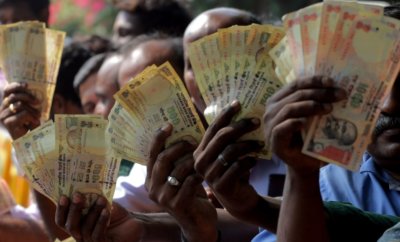Business
Only Over 1% of Indian Regular Employees Earn More Than Rs 50,000 Per Month: Report

Representational Image
Photo: IANS
"In the age of corporate compensation packages exceeding Rs 20 lakh a year, it is sobering to learn that earning over Rs 1 lakh per month puts a household in the top 0.2 per cent of income earners in the country," the study, “State of Working India,” by Azim Premji University, said.
Despite high economic growth, Indians continue to get low wages, with 57 percent of regular Indian employees earning up to Rs. 10,000 per month in 2015, according to a recent report.
Only 1.6 percent of Indian regular employees earned Rs. 50,000 or more per month, the study, “State of Working India,” by Azim Premji University, said, adding that a large majority of Indians are not being paid what is termed a living wage.
“The key measure of the quality of jobs is, perhaps, how remunerative they are. Broadly speaking, wage levels have remained low and have grown slowly over the last three decades,” the report said. “Even among regular wage workers, more than half (57%) have monthly average earnings of Rs 10,000 or less, well under the Seventh Central Pay Commission minimum stipulated salary of Rs 18,000 per month. As for casual workers, 59 percent have monthly earnings of up to Rs 5,000.”
Between 2010 and 2015, wages, adjusted for inflation, grew at 2 percent per annum for organized manufacturing, 4 percent for unorganized manufacturing, 5 percent for unorganized services, and 7 percent for agriculture. Since 2000, real wages have grown at around 3-4 percent in most sectors, except for agriculture. At this rate, real wages double every two decades. Even in the organized manufacturing sector, 90 percent of the industries pay wages below the CPC minimum. The situation is worse in the unorganized sector, the report said.
The average monthly salary of regular workers is Rs. 13,562 while non-regular employees earned Rs. 5,853 per month. “This can probably account for the extremely high demand for government employment seen all over the country,” it said.
In total, 98 per cent earned less than Rs 50,000 per month. “In the age of corporate compensation packages exceeding Rs 20 lakh a year, it is sobering to learn that earning over Rs 1 lakh per month puts a household in the top 0.2 per cent of income earners in the country,” the report said.
Among the self-employed, 3.5 percent earned between Rs. 20,001 and 50,000 per month while 0.4 percent earned between Rs. 20,001 and Rs. 50,000. Only 0.1 percent earned more than Rs 1 lakh per month in 2015-16.
In the same period, among regular wage or salaried people, 17.7 percent earned between Rs. 20,001 and 50,000 and only 1.4 percent earned between Rs. 50,001 and Rs 1,00,000. Only 0.2 percent reported earning over Rs. 1 lakh per month.
For contract workers, 2.1 percent were in the salary range of Rs. 20,001 to Rs 50,000 per month while only 0.1 percent earned Rs. 50,000-1,00,000. None reported earning more than Rs 1 lakh monthly.
Although India grew at a better rate, that growth did not or has not translated into jobs. In fact, that growth created fewer jobs than it used to, according to the report. A 10 percent increase in GDP now results in less than 1 percent increase in employment. “Even as GDP growth rates have risen, the relationship between growth and employment generation has become weaker over time,” it said.
In the 1970s and 1980s, when the GDP growth was around 3-4 percent, employment growth was around 2 percent per annum. Since the 1990s, and particularly in the 2000s, while GDP growth has accelerated to 7 percent, employment growth has slowed to 1 percent or even less. The ratio of GDP growth to employment growth is now less than 0.1, the report said.
Between 2013 and 2015, total employment shrank by seven million, and the absolute decline has continued past 2015. “As a result, the rate of unemployment among the youth and higher educated has reached 16 percent,” the report said.
“It used to be said that India’s problem is not unemployment but underemployment and low wages,” it said, “but a new feature of the economy is a high rate of open unemployment, which is now over 5 percent overall, and a much higher 16 per cent for youth and the higher educated.”
The increase in unemployment is clearly visible across India, but is particularly severe in the northern states, the report said, adding that labor productivity in organized manufacturing increased by six times over the past three decades, but wages increased by only 1.5 times.



